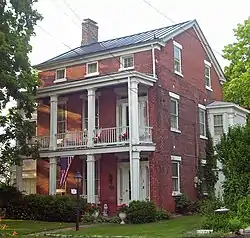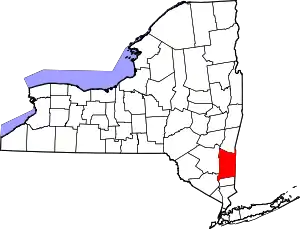New Hamburg, New York
New Hamburg is a small hamlet (and census-designated place)[1] along the Hudson River in Dutchess County, New York, best known as home of a popular marina and a busy Metro-North Railroad Hudson Line station. It is located in the southern corner of the Town Of Poughkeepsie.
History
Early history

Road records of 1770 show that there were shipping facilities in New Hamburg called “Hood Landing.” Rivermen called the rocky point of land in the angle between the Hudson and the mouth of Wappinger Creek "High Point" and the area which projected into the river a few miles south "Low Point" (Chelsea).[2]
Lime burning became an important industry. Dr. Benjamin Ely's map of 1797 shows a lime kiln in New Hamburg. By 1800 Ephraim DuBois had settled at High Point. In 1837 he sold his property, including a lime quarry and kiln, to Adolph Brower from New York. Brower's customers were local pig iron producers and farmers and builders as far away as New Jersey, supplied by river boat. He tore down the DuBois house and built his own on the same site about 1844. New Hamburg Yacht Club is now situated approximately where the "Old Lime Dock" was. The riverfront near the lime kilns was a favorite local bathing area called the "Sandy Bottom Shore.” When the railroad was built in the late 1840s, excess stone was tossed onto the naturally sandy beach area.[2]
In 1808 John Drake Jr. built a bridge across Wappingers Creek. In 1879 an iron swing-bridge was erected, and continued to be known as "Drake's Bridge".[3]
By 1810 John Drake had relocated to the hamlet where he had docks, a store, and 30 acres of land at High Point, then known as "Wappingers Landing".[4] In the early 1820s, lumber surpassed lime kilns as a business. Charles Millard, who owned a lumber business based in Ulster County, moved to the Landing in 1824 and opened a lumber yard. Since most of the lumber and log shipments were made by water, Millard's son, Walter, branched out into ship building and freighting. He and a partner, Uriah Mills, built the barge Lexington, which carried freight up and down the Hudson River and the steamer Splendid, which carried both freight and passengers.[2] New Hamburg became a port community on the river, with ships loaded and unloaded along nearby Point Street and then taken to Poughkeepsie and Wappingers Falls via road. In 1837, the postmaster was Walter Millard.[5]
In 1848 construction began on the Hudson River Railroad in order to expand the Troy and Greenbush Railroad from the Albany area to New York City. In 1848–1849 a cholera epidemic swept through the community of railroad workers. It is recorded that Father J. Scollon, of St. Mary's in nearby Channingville, being called to High Point, labored unceasingly to relieve the sick and the dying.[6] The outbreak caused a number of fatalities among the workers, and construction was delayed. An 800-foot (240 m) tunnel was built through a hillside north of town, and the work being done there triggered the development of Main Street as a commercial area.
The river steamer Mary Powell used to stop at New Hamburg in the morning on her way to New York and in the afternoon on the return trip.[3]
Around 1860 William Shay operated a rag business on the corner of Main Street and Point Street. He would travel up Wappingers Creek to the mills in Wappingers Falls, and obtain rags and cotton waste for transshipment. The hamlet suffered a devastating fire on May 3, 1877, involving the loss of seven buildings.[3]
The New Hamburg Yacht Club was originally incorporated in 1869 as an ice boat club. In February 1871, on the railroad drawbridge over the Wappinger Creek along the Hudson between the towns of Poughkeepsie and Wappinger, a train traveling north collided with an oil tank train car heading south. The trains exploded upon impact instantly throwing people, luggage, and train parts into the water. 77 people were missing or unidentified. The number of confirmed deaths was 22. Some bodies were taken to Poughkeepsie for identification; many were never recovered.
The area around New Hamburg was the location of a number of country estates such as that of New York City attorney, Francis Robert Rives, which was located on Rives Avenue,[7] as well as that of J. Fisher Sheefe.[8]
In 1929 the Children's Aid Society of New York operated a farm school for older boys, at Bowdoin Farm in New Hamburg N.Y. in 1929 to train boys in farm work and give them a taste of what to expect, before placing them as paid laborers on farms in the country.[9]
Geography
The latitude of New Hamburg is 41.588N. The longitude is -73.945W. It is in the Eastern Standard time zone. Elevation is 69 feet.
Services
The Metro-North commuter train station has two tracks and platforms, with south-bound service to Grand Central Terminal, New York City (travel time: approx. 90 minutes) and north-bound service to Poughkeepsie, NY (travel time: approx. 16 minutes).
The New Hamburg Fire Department provides Fire and Emergency Medical Service response for the entire hamlet of New Hamburg.
New Hamburg Park, on Main St., is under the jurisdiction of the Town of Poughkeepsie Recreation Dept. It contains tennis courts, a playground, a baseball field and part of the Wappinger Greenway Trail. It adjoins the Reese Audubon Sanctuary.[10]
See also
References
- "State of New York Census Designated Places - Current/BAS20 - Data as of January 1, 2019". tigerweb.geo.census.gov. Retrieved 2020-02-24.
- "History", New Hamburg YachtClub
- Smith. James H., History of Dutchess County New York, D.Mason & Sons, Syracuse, 1882
- Platt, Edmund. "Town and City of Poughkeepsie", History of Dutchess County, New York, (ed. Frank Hasbrouck), S.A.Mathieu, Poughkeepsie, N.Y. (1909)
- United States Official Postal Guide, United States. Post Office Department, 1837, p. 116
- "History of St.Mary's". Archived from the original on 2001-02-12. Retrieved 2018-02-20.
- Hall, Henry. "Francis Robert Rives", America's Successful Men of Affairs, New York tribune, 1895, p. 541
- Transactions of the New-York State Agricultural Society, vol. 6, 1847,p. 681
- "Children’s Aid Society of New York", The Social Welfare History Project
- "New Hamburg Park", Town of Poughkeepsie Recreation Department
External links
| Wikimedia Commons has media related to New Hamburg, New York. |
